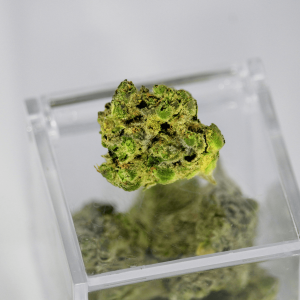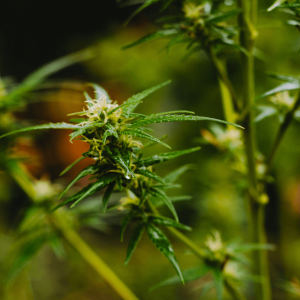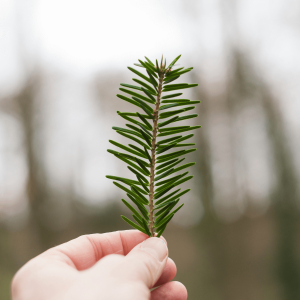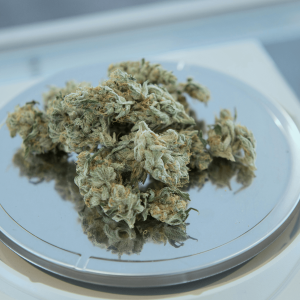Terpenes are the aromatic compounds found in many plants, giving them their distinct scents and flavors. These little molecules are more than just nature’s perfumes; they play significant roles in the plant’s own life and have a number of benefits for us humans.
In the world of hemp and cannabis, terpenes are essential not just for their aromatic diversity but also for their potential therapeutic effects. Among the many terpenes, like myrcene, limonene, and linalool, pinene stands out as a key player.
Pinene terpene, with its fresh pine scent, is one of the most abundantly found terpenes in cannabis. Throughout this blog, we’ll dive deep into what pinene is, explore its properties, and understand its importance in hemp and cannabis. Let’s begin!
What is Pinene?
So, what exactly is pinene anyway? Well, to start, pinene is a type of terpene, which, as we already touched on, are those beneficial aromatic compounds found in many plants.
Pinene is specifically named for its pine-like scent and is one of the most common terpenes in nature and cannabis.

Chemical Structure of Pinene
Pinene is a hydrocarbon with a bicyclic structure, meaning it has two connected rings as part of its molecular structure. Its formula is C10H16, and it comes in two structural isomers: alpha-pinene and beta-pinene. These isomers are almost identical but differ slightly in the position of a double bond within the molecule, giving them distinct properties.
Types of Pinene: Alpha-Pinene and Beta-Pinene
There are two main types of pinene:
- Alpha-Pinene: This is the most abundant terpene form of pinene found in nature. It has a strong, fresh pine scent and is known for its anti-inflammatory and bronchodilator effects.
- Beta-Pinene: This form has a more woody-green, basil-like aroma. It’s less common than alpha-pinene but still offers benefits like antimicrobial and antioxidant properties.
Natural Sources of Pinene Beyond Hemp and Cannabis
Pinene isn’t just found in hemp and cannabis; it’s in many other plants too! Here are a few natural sources where you can find pinene:
- Pine Trees: Not too surprising, given the name, but pine trees and pine needles, like the ponderosa pine, are rich in pinene.
- Herbs and Spices: Rosemary, basil, and parsley all contain pinene.
- Citrus Fruits: The peels of oranges and lemons also have pinene.
- Coniferous Trees: Apart from pine, trees like fir, spruce, and juniper also produce pinene.
- Eucalyptus: Eucalyptus trees are another great source of this fresh, piney terpene.
So, as you can see, pinene is widespread in nature and serves a variety of purposes, both for the plants themselves and potentially for us humans too.
The Role of Pinene in Plants
Pinene plays an essential role in the natural world, primarily by acting as a defense mechanism for plants. When a plant is under threat, such as from herbivores or pathogens, it often releases pinene to repel these invaders. This terpene works as a natural insect repellent, preventing pests from munching on leaves or burrowing into bark.
Additionally, pinene has antimicrobial properties, helping to ward off harmful bacteria and fungi that might otherwise infect the plant.
Beyond defense, pinene also plays a role in attracting pollinators. The fresh, piney scent is not just pleasant to our noses; it’s also a signal to pollinators like bees and butterflies that a plant is ready for pollination, ensuring the plant’s reproductive success. From an ecological perspective, the release of pinene into the atmosphere helps maintain plant health and contributes to the complex web of plant and animal interactions.
The overall significance of pinene extends even further, as it influences local ecosystems by supporting the balance between plant species and their pollinators and predators, thus maintaining biodiversity.
Pinene in Hemp and Cannabis
Pinene is produced in hemp and cannabis plants through a complex biosynthetic pathway that involves the precursor molecule geranyl pyrophosphate (GPP). This precursor undergoes a series of enzymatic reactions to form pinene, among other terpenes.
The production of pinene is heavily influenced by the plant’s genetic makeup as well as environmental factors. Different strains of hemp and cannabis can have varying concentrations of pinene, with sativa strains generally boasting higher levels of this terpene.
Strains like Jack Herer and Blue Dream are renowned for their rich pinene profiles. Moreover, cultivation methods such as soil type, light exposure, and nutrient availability all play a critical role in determining the levels of pinene found in a particular plant. Organic farming practices and specific growing conditions can enhance or diminish the concentration of this aromatic compound.

Pinene and the Entourage Effect
The entourage effect is a phenomenon where various compounds in cannabis, such as cannabinoids and terpenes, collaborate to create a more potent therapeutic impact than they would on their own. This effect isn’t limited to cannabis; it can also be observed with psychedelics like Penis Envy mushrooms, where multiple compounds work together to enhance the overall experience.
Pinene is a key player in this synergy depending on the strain’s terpene composition. Interacting with other cannabinoids like THC and CBD to enhance and modulate their effects, pinene can counteract some of the cognitive distortions caused by high levels of THC high pinene cannabis, leading to a more balanced and clear-headed experience.
In full-spectrum CBD and THC products, the presence of pinene alongside other terpenes and cannabinoids can amplify the overall benefits, offering a more holistic approach to wellness. This synergistic interaction makes full-spectrum products particularly appealing to those seeking natural remedies for conditions such as anxiety, inflammation, and pain.
Therapeutic Benefits of Pinene
- Anti-inflammatory properties: Pinene has been shown to possess anti-inflammatory effects, making it useful in managing conditions like arthritis and inflammatory diseases.
- Bronchodilator effects aiding respiratory conditions: This cannabis terpene acts as a natural bronchodilator, which can help open up airways and improve breathing for those with asthma or other respiratory issues.
- Potential anti-cancer properties: Some studies suggest that pinene may have anti-cancer properties, potentially aiding in the inhibition of cancer cell growth.
- Impact on cognition and memory: Pinene is believed to enhance cognitive function and improve memory by inhibiting the breakdown of acetylcholine, a neurotransmitter essential for learning and memory.
Pinene’s Aromatherapy and Medicinal Uses
Pinene is a popular choice in aromatherapy due to its fresh, invigorating scent that promotes alertness and mental clarity. People often use pinene-infused products like essential oils and balms to reap its therapeutic benefits.
In aromatherapy, diffusing pinene essential oil can help clear the mind, ease stress, and improve focus. When applied topically in balms or oils, pinene may provide localized pain relief and reduce inflammation, making it a go-to for soothing muscle aches and joint pains.
Traditionally, pinene has been used in herbal medicine to treat respiratory issues, enhance cognitive function, and even as a natural antiseptic. Whether it’s through inhalation, direct application, or herbal remedies, pinene continues to be a versatile and valuable component in both modern and traditional medicinal practices.
Scientific Studies on Pinene
The scientific community has increasingly turned its attention to pinene, uncovering a wealth of information about its medicinal effects. A multitude of studies have explored pinene’s anti-inflammatory properties, with research indicating that this cannabis terpene can effectively reduce inflammation, which is beneficial in treating conditions like arthritis and inflammatory bowel disease.
Additionally, studies focusing on pinene’s impact on respiratory health have found that pinene can function as a bronchodilator, helping to open airways and improve breathing in conditions such as asthma.
Another exciting area of research has examined pinene’s potential anti-cancer properties. Preliminary studies suggest that pinene may inhibit the growth of certain cancer cells, although further research is required to confirm these findings and determine the mechanisms involved.
Similarly, studies on pinene’s cognitive benefits have demonstrated that it can enhance memory and learning by preventing the degradation of acetylcholine, a crucial neurotransmitter for cognitive function.
Looking ahead, future research is poised to dive deeper into understanding pinene’s full spectrum of benefits and applications. Emerging studies are particularly interested in exploring the synergistic effects of pinene when used in combination with other cannabinoids and terpenes, commonly referred to as the entourage effect.
Researchers are also keen to investigate the long-term effects of pinene use and its potential for integration into mainstream medical treatments. As the body of evidence grows, pinene’s role in natural medicine continues to expand, promising new and innovative uses for this versatile compound.

Pinene in Hemp-Derived CBD Products
Hemp-derived CBD products come in a variety of forms, each designed to meet different needs and preferences. Some of the most popular products include CBD oils, tinctures, edibles, and topicals. Many of these products are formulated with pinene to leverage its unique benefits.
Pinene-rich CBD oils are highly regarded for their rapid absorption and user-friendly application. Similarly, tinctures often include pinene for its aromatic properties and potential health benefits. For those who prefer edibles, pinene can also be infused into gummies and capsules, providing a delightful way to enjoy your daily dose of CBD while benefiting from the unique advantages of this terpene. Hemp gummies, in particular, offer a flavorful and convenient option, combining the benefits of CBD with the added properties of pinene for a well-rounded wellness experience.
Benefits of Incorporating Pinene in CBD Oils, Tinctures, and Edibles
Integrating pinene into CBD products like oils, tinctures, and edibles enhances their overall efficacy and appeal.
For instance, pinene’s anti-inflammatory properties make it an excellent addition to CBD oils and tinctures, potentially boosting their effectiveness in managing pain and inflammation. The bronchodilator effects of pinene can complement CBD’s calming properties, making it a valuable component in products aimed at alleviating respiratory issues.
When used in edibles, pinene not only enhances the flavor profile with its fresh, pine-like aroma but also supports cognitive function and memory. This combination of benefits makes pinene-infused CBD products a holistic approach to wellness, appealing to those seeking natural and multi-faceted solutions for their health concerns.
Pinene’s Role in Recreational Cannabis
Pinene is one of the many terpenes that contribute to the unique flavor and aroma profiles of various cannabis strains.
Imagine taking a deep breath in a pine forest—fresh, invigorating, and earthy. That’s what pinene brings to the table. Its crisp, forest-like scent is immediately recognizable and can make smoking or vaping a more pleasurable and refreshing experience.
This terpene not only adds to the strain’s olfactory bouquet but also enhances its complexity with a hint of resinous sweetness.
Influence on the Overall Psychoactive Experience
But pinene isn’t just about making your weed smell good. It also plays a significant role in the overall psychoactive experience. Known for its potential to increase alertness and improve memory, pinene can counterbalance some of the forgetfulness and cognitive haze often associated with high-THC strains.
Additionally, its bronchodilator properties can make breathing easier, smoothing the intake process and potentially reducing respiratory discomfort during inhalation. The presence of pinene in cannabis can create a well-rounded high, making it a popular choice for those who seek a more clear-headed and balanced experience.
Popular Pinene-Rich Cannabis Strains
If you’re interested in experiencing pinene for yourself, there are several cannabis strains known for their high pinene content. Some of the most beloved include:
- Jack Herer: This strain is a Sativa-dominant hybrid known for its energizing and creative effects. It carries a sweet, piney aroma that’s enriched by the presence of pinene.
- Blue Dream: A well-balanced hybrid with a blend of relaxing and uplifting effects, Blue Dream also features a prominent pinene profile, adding a crisp, forest-like note to its sweet berry aroma.
- OG Kush: With its potent effects and complex terpene profile, OG Kush is a classic strain that showcases pinene’s piney, woodsy aroma, contributing to its overall earthy and aromatic charm.
By choosing strains rich in pinene, recreational cannabis users can enjoy not just the aromatic benefits but also a more refined and possibly smoother psychoactive experience. Whether you’re partaking for relaxation, creativity, or socialization, pinene-rich strains offer a holistic approach to enhancing your cannabis journey.

Cultivating Pinene-Rich Hemp and Cannabis Strains
Growing high-pinene hemp and cannabis strains requires a combination of careful strain selection and optimal cultivation practices.
First and foremost, choosing strains known for their pinene content, such as Jack Herer, Blue Dream, and OG Kush, sets the foundation for a successful crop. Ensuring ideal growing conditions is crucial; this includes maintaining the right temperature, humidity, and light cycles.
Pinene production in plants can be enhanced by providing a nutrient-rich soil mix and employing organic farming techniques. Regular pruning and training methods such as topping and low-stress training (LST) can also improve airflow and light penetration, which promotes healthier and more resinous plants.
Additionally, implementing integrated pest management (IPM) practices helps to mitigate stress factors that might otherwise hinder terpene production. Stress factors such as overwatering, nutrient imbalances, and pest infestations can negatively impact the synthesis of pinene. Ensuring plants are well-supported through stakes or trellising systems can further reduce physical stress.
Another tip for enhancing pinene production is to use compost teas and foliar sprays rich in humic acids during the flowering stage. These natural supplements can elevate terpene levels and boost plant vigor, leading to a higher yield of pinene-rich flowers.
Profiles of notable high-pinene hemp and cannabis strains often showcase their versatility and resilience, making them an excellent choice for both novice and experienced growers aiming to cultivate aromatic and potent plants.
Extraction and Isolation of Pinene
Extracting pinene from hemp and cannabis plants involves techniques that maximize the yield and purity of the compound. One of the most common methods is steam distillation, where steam is passed through the plant material to vaporize the pinene, which is then condensed and collected. This method is particularly favored for its ability to preserve the aromatic integrity of terpenes.
Another popular technique is solvent extraction, which uses solvents like ethanol or supercritical CO2 to dissolve the pinene from plant material. Supercritical CO2 extraction, in particular, is renowned for its precision and safety, producing high-purity pinene without residual solvents.
Commercial isolation processes often involve fractional distillation, which separates pinene from other compounds based on their boiling points. This meticulous process ensures the isolation of pure pinene, which is essential for applications in the fragrance, pharmaceutical, and food industries.
However, challenges associated with pinene extraction include the potential degradation of the terpene due to high temperatures or improper storage conditions. Maintaining a controlled environment during extraction and storage is vital to preserve pinene’s chemical stability and aromatic properties.
The demand for pure pinene continues to drive innovation in extraction technologies, aiming to improve efficiency and yield while minimizing environmental impact.
Potential Side Effects and Considerations
While pinene-rich strains of cannabis can offer several benefits, it’s essential to be mindful of potential side effects and considerations, especially with high intake.
For some individuals, high levels of pinene may lead to mild irritations such as dryness of the mouth and eyes, or in rare cases, an increase in heart rate and anxiety levels. Those who have allergies or sensitivities to terpenes, particularly to pine nuts or related trees, should be cautious when trying pinene-dominant strains, as they may experience allergic reactions, ranging from mild symptoms like sneezing and itching to more severe respiratory issues.
It’s recommended to start with small doses and observe how your body reacts before considering larger amounts.
Furthermore, individuals with asthma should be particularly vigilant, given that while pinene has bronchodilator properties, excessive inhalation could potentially irritate the respiratory system, particularly if not properly processed or stored.
Guidelines for safe consumption include consulting with a healthcare provider if you have pre-existing health conditions, purchasing products from reputable sources that provide detailed lab reports, and ensuring proper storage to preserve the integrity of the pinene content. By adopting these precautions, users can responsibly enjoy the benefits of pinene in cannabis while minimizing any potential adverse effects.
Legal and Regulatory Aspects
When it comes to the legal and regulatory status of pinene, there’s quite a bit of variation across different regions. In the United States, for instance, pinene as a terpene is generally recognized as safe (GRAS) by the Food and Drug Administration (FDA) for use in food, beverages, and cosmetics.
However, its inclusion in cannabis products is governed by state laws, which can vary significantly. Some states with legal cannabis markets have specific regulations on terpene utilization and labeling, while others adopt a more straightforward approach. In the European Union, pinene is permitted for use in similar applications, but compliance with REACH (Registration, Evaluation, Authorization, and Restriction of Chemicals) regulations is necessary to ensure safety and environmental consideration.
Legal considerations for pinene-infused products mostly revolve around ensuring that these products meet labeling and safety standards set forth by local authorities. This often involves detailed labeling of terpene content, adherence to standards of purity and quality, and ensuring that any infused products do not contain potentially harmful residues or contaminants. Producers are also required to provide transparency in their extraction methods to meet regulatory requirements and reassure consumers of the product’s safety and efficacy.
The impact of legislation on the pinene market is notable—regulations can either foster growth or constrain it, depending on the stringency of the rules and how they are enforced. For example, in regions where cannabis has been legalized for medical or recreational use, the market for pinene and other terpenes has seen significant expansion, driven by consumer demand for natural and effective terpene profiles.
Conversely, in areas with strict regulatory environments or outright bans on cannabis products, the pinene market could face hurdles that hinder growth. Ongoing legislative shifts and regulatory updates continue to shape the landscape, and staying informed about changes is crucial for businesses and consumers alike to navigate this dynamic market effectively.
Conclusion: The Future of Pinene in Hemp and Cannabis Industry
The future of pinene terpene in the hemp and cannabis industry looks incredibly promising, driven by emerging trends, innovations, and the rise of cannabis delivery services that are pushing the boundaries of what’s possible. From advanced extraction techniques that yield higher purity levels to more refined applications in medicinal and recreational products, pinene is poised to play a crucial role.
As research and consumer interest in natural, plant-based compounds continue to grow, pinene’s potential to shape the future of hemp and cannabis products becomes ever more apparent. This versatile terpene not only enhances flavor and aroma profiles but also offers notable therapeutic benefits, such as anti-inflammatory and bronchodilator properties.
While the landscape is still evolving, the commercial and therapeutic potential of pinene, coupled with the convenience of cannabis delivery, could unlock new opportunities for innovation, making it a key player in the future of the industry. With ongoing developments and increased understanding, pinene terpene may well become a cornerstone in the next generation of hemp and cannabis products.

Frequently Asked Questions
1. What are the effects of high pinene?
High pinene levels in cannabis strains can provide a range of effects. Pinene is known for its uplifting and energizing properties, which can help improve focus and alertness. It also has anti-inflammatory and bronchodilator effects, making it beneficial for conditions such as asthma and other respiratory issues.
2. What are the side effects of pinene?
Like any compound, pinene can cause side effects, especially if consumed in large quantities. Common side effects may include dryness of the mouth and eyes. In rare cases, it could lead to an increased heart rate or heightened anxiety levels. Individuals with allergies to pine nuts or related trees should be cautious, as they might experience allergic reactions, ranging from mild symptoms like sneezing and itching to more severe respiratory issues.
3. Does pinene make you sleepy?
Pinene is generally associated with alertness and can potentially counteract feelings of drowsiness, which makes it less likely to induce sleep. Instead, it tends to promote a sense of focus and energy. Of course, the overall effect can vary depending on the specific strain of cannabis and the presence of other terpenes and cannabinoids.
4. What is the function of pinene?
Pinene is a naturally occurring terpene found in many plants, including pine trees, rosemary, pine needles, and cannabis. Its primary function in plants is to act as a protective agent against pests and pathogens. Additionally, in cannabis, pinene contributes to the distinctive aroma and has various therapeutic benefits, such as anti-inflammatory, bronchodilator, and cognitive-enhancing properties.

 Rewards
Rewards




